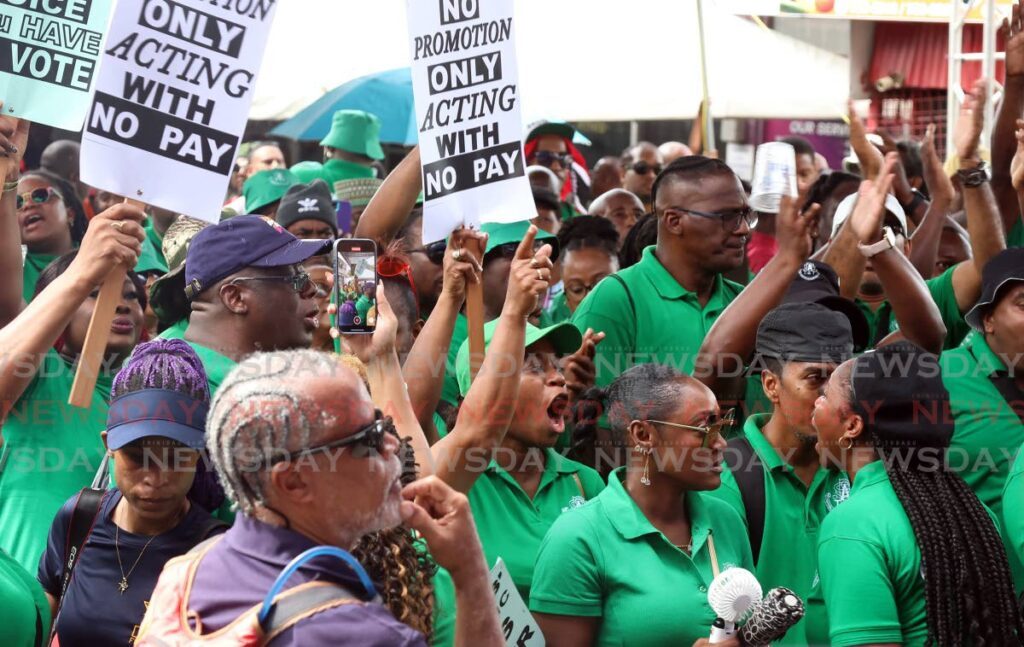Is labour history repeating itself?

Fascinated by the way history repeats itself, particularly when you pick up a newspaper and see that what goes round comes round, I watched as trade unions were encouraged to join in a request for what was once perceived as a socialist government, or what appears to be an appeal for a political structure of democratic socialism.
The pictured masses of working people were marching against not only the Prime Minister but, if I understood correctly, against the entire political structure for which he stands.
And I had a flashback to a similar time, as recorded by Industrial Court judge and author Dr Zin Henry, to an organisation formed in 1897, by a man called Walter Mills, a pharmacist.
It was known as the Trinidad Workingman’s Association (TWA). It was not a trade union as we know it now: it was just what it said, an association of working people, men and women, drawn up to formally protest to the colonial government over their impoverished living conditions.
It took almost ten years, as it slowly grew for a chemist – what we now would probably refer to as a pharmacist – named Alfred Richards to take it over and impose some structure to it.
He gave it a motto: Agitate, Educate and Confederate.
If that sounds familiar to those who followed the Movement for Social Justice’s leader David Abdulah’s Labour Day speech last week, it sounded familiar to me as well.
As I went back in time to the TWA, I remembered its early demands, asking the Colonial Office – at that time TT’s governing body in the UK – for shorter working hours, overtime pay, sick leave with pay and free medicine.
These were demands regarded under the "agitate" motto as being revolutionary at the time.
Current demands by those marching over Labour Day under the "agitate" rubric veer more towards implementing past negotiations that state enterprises agreed to long ago but no longer have the income to pay. These include, but are by no means limited to T&TEC, fire services, daily-paid workers, TSTT, UWI, UTT, NP, Powergen, National Quarries, NTA, prison officers, police, coast guard, regiment, port workers, nurses, doctors, medical workers, teachers, PTSC.
As in most socialist countries, Government employs a substantial number of citizens in essential services. Many of them are going past just agitation for increased income, even as they did back in the days of the TWA, but also for the reformation of labour laws that some stakeholders in industry feel need upgrading and, more importantly, agitation for change in the structure of the system itself.
As for education, the TWA struggle for universal education to provide knowledge that will lead to skills appropriate to the job market of the time now faces a reversal in the diminution of GATE and scholarship funding, limiting the places available in specialist medical fields that are priced out of the reach of most young adults.
Despite the almost 200-year gap, that is not much different from what the TWA agitated for.
When the TWA began to gain momentum, to the more discerning, it was evident that the "confederate" part of the motto had an aspect of equality superior to ours.
Membership consisted of both men and women – home-builders, housewives and homemakers – those workers who by their labour in providing meals, sanitation, childcare, home gardens and primary medical solutions, allowed others from those homes time to work in factories, fields, shops, offices, etc.
All were full members with the title of "workers," for which they were recognised and respected. There was less gender discrimination than there is now in the structure of workers’ organisations, where men dominate in the power and decision-making positions.
Had it been left to grow and expand, the TWA would have changed the culture and governance of how we live now and the current demands being made foreshadow this.
In 1932, according to CLR James, the TWA comprised 98 sections, each one appointing officers and keeping accounts.
Today there are only 84 registered trade unions, many of them quiescent. Back then there was an island-wide congress, with delegates meeting once every quarter. That kind of unity does not exist any more.
By 1936, TWA had 125,000 members out of a population of approximately 520,000 – a whopping 24 per cent of the entire population, a solid foundation for what could have become a very democratic socialist government.
Today, the percentage unionised is under 18 per cent. Do the maths. Out of a population of, the CSO says 1,538,200, a workforce of 577,000 and a unionised workforce, claimed on the internet – although admittedly not by Cecil Paul, whose statistics I could not find, but generally trust – of 100,000.
The speeches made this Labour Day about a coalescence of political and trade-union organisations were reminiscent of the aims of those TWA heydays. But back then, it never happened.
Their very potential political power was a threat to the Colonial Office and it persuaded the members to separate into units concerned only with the individual trades they worked in, according to Henry. By the end of the decade, the TWA had disintegrated. The strategy worked.
Is it now trying to regenerate? Reincarnate?

Comments
"Is labour history repeating itself?"